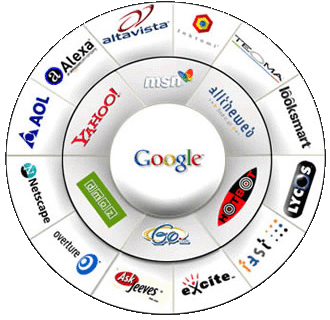Overview:
When websites are being built, many people ask a version of this question, "I want my website to be at the top of the page for this and that." Of course, everyone wants that. But, only so much is possible, and one of the nerve racking factors for the webmaster and client is time.
When people here this response, "Time, a lot of what Google ranks takes time. The time comes after everything else; a near-perfect, well written website. And, don’t expect a bargain website for a few hundred dollars is going to push the largest competitors out of the way. It just does not work like that. These big companies hire employees to keep building more sites on different ips, set up many blogs and make links through all sorts of methods. Are you willing to match the $100,000/year that the Big Fish pays?" At this point, they kind of get an idea that there is more to a website than 5 pages and bunch of tricks. The five pages and a bunch of tricks of the trade will help, but, there will be key holes to exploit rather than takeover the ranks of the ‘Big Fish’ who spend and work to stay on top.
Back To Time:
Due to how the web has evolved, Google does not reward a new site with a great rank right off the bat. After the site is submitted, or a sitemap is made and submitted, Google will eventually index the site. Since so much spam and fly-by-night outfits pop up all over the place, search engines like Google have every right to be skeptical of newcomers pumping out spam. But, as the site sticks around and goes through frequent editing and new content is added, its placement and coverage of keywords and phrases tends to become solid and visitors increase.
Overview:
Sitemaps are files which contain links of files of some or all of the files on a website. Often, sitemaps can be seen by clicking on a link on the website. Sitemaps on websites probably contain an html file with the links. This sort of sitemap is really an index with a reinvented name to give it a web specific meaning. Another form of sitemap that can be used index webpages with Google Webmaster tools is an XML file.
XML Sitemaps:
XML sitemaps can be submitted to Google Webmaster Tools. XML files can be created in software such as Notepad, Dreamweaver and Adobe Framemaker. If a sitemap is to have a stylesheet it would be a XSL stylesheet.
An XML sitemap file is shown below:
<?xml version=’1.0′ encoding=’UTF-8′?><?xml-stylesheet type="text/xsl" href="https://fullstackwebstudio.com/locations/coding-blog//sitemap.xsl"?>
<urlset xmlns:xsi="http://www.w3.org/2001/XMLSchema-instance" xsi:schemaLocation="http://www.sitemaps.org/schemas/sitemap/0.9 http://www.sitemaps.org/schemas/sitemap/0.9/sitemap.xsd" xmlns="http://www.sitemaps.org/schemas/sitemap/0.9">
<url>
<loc>https://fullstackwebstudio.com/locations/coding-blog/</loc>
<lastmod>2009-07-26T07:17:59Z</lastmod>
<priority>0.6</priority>
<changefreq>weekly</changefreq>
</url></urlset>
Note:
The XML file above states the version, encoding (must be UTF-8), stylesheet link(if used) and has all links nested in between <urlset></urlset> tags. each link in the sitemap is located between <url><</url> tags.
Multiple XML Sitemaps:
If sites become very large with thousands of pages, one sitemap index file can be made that will use contain the sitemap files. The sitemaps would be made like the one shown in the previous example, while the sitemap index would have this code (without stylesheet) below:
<?xml version="1.0" encoding="UTF-8"?>
<sitemapindex xmlns="http://www.sitemaps.org/schemas/sitemap/0.9">
<sitemap>
<loc>http://www.example.com/sitemap1.xml.gz</loc>
<lastmod>2008-11-01T18:25:17+00:00</lastmod>
</sitemap>
<sitemap>
<loc>http://www.example.com/sitemap2.xml</loc>
<lastmod>2008-04-01</lastmod>
</sitemap>
</sitemapindex>
Pros
Sitemaps can be submitted to Google, Yahoo and Bing. Google even shows how many of the pages in the sitemap are indexed. One XML file can be used to index hundreds of links.
Validation
If you are concerned with the code of your xml file you can run it through W3C Markup Validation Service.
Overview:
A very important part of any SEO campaign is monitor traffic. Although you want to see how many visitors came to your website, it is very important to analyze the visits. With stat tools, you can make a relatively accurate guess about what pages people come too see, how long they view them and how they got there. There are many stat tools to test stats, but, this discussion will only deal with two of the most popular stat tools; Google Analytics and AWSTATS.
Google Analytics:
Google Analytics is a free tool that you can log into with a GMAIL account username and password.
Pros
Google Analytics does a fantastic job at breaking down the visitors into many subcategories such as cities, countries, connection speed and browsers. Any of the ‘Referral Paths’ exists for any of the ‘Traffic Sources’; such as referral, organic and direct. It also shows which pages have been visited and how long someone stays on the page. The stay on the page part can be misleading because they must move to another page on the site for a reference point to be made. Therefore, if someone stays on one page for 10 minutes and then shuts off his computer while someone else visits that page for two minutes and moves another page on your site this will read 1 minute average spent.
Cons
One pitfall of Google Analytics is that the cookie that is used for tracking the data will be used as long as that cookie is stored. This means that if someone originally arrives at your site from a link, each and every visit thereafter with that cookie will be shown from the traffic source as a ‘Referral’ not a direct visitor. Considering that the cookie must be removed and refreshing or reloading will not do a lot of good, those numbers are very problematic. This is where AWSTATS can come to the rescue because it can determine how a visitor arrives at the site.
AWSTATS:
AWSTATS is often freely provided with a hosting account.
Pros
AWSTATS uses the server log files to determine visitor info. If you compare AWSTATS where users come from and Google, you may find that Google Analytics and AWSTATS vary dramatically with the info regarding where the users came from. AWSTATS may state that 80% come from a bookmark or direct link from email while Google Analytics might state that most come from a referral page. The big difference here is that Google Analytics will use one cookie in the user’s computer and AWSTATS uses server log files. Like it was mentioned earlier, that cookie has the potential to reveal rather accurate visitor numbers (unless the script is blocked) but it does not do a great job at handling determining precise data how a visitor returns to the website.
Cons
There are not many cons about AWSTATS. It is a very popular choice for webmasters to determine visits and visitor info. It does a pretty good job at breaking down information such as what pages had been entered and which ones had been exited. As far as where visitors come from, it breaks them down to the country with the unique IP addresses. Google Analytics has a slight edge here becasue it tracks the user down to the city. It is not perfect, but, it could show something like a visitor from West Vancouver who is actually living in North Vancouver.
CMS MODULES / COMPONENTS:
There are addons that can be used with a Content Management System to determine visitor stats. For example, Joomla has a component and module called Joomlastats. This tool will store info in the database about the users, such as what pages were visited and where they come from. The third opinion from a component / module can be very useful. The negative aspect to using one of the components / modules is that a lot of data will accumulate in the database and that could hinder SEO and website speed as search engines query the database; even with compressed data. The program Joomlastats and AWSTATS show very very similar data, numbers and IP addresses of the visits. Both will exclude bots. One of the nice features of a stat analyzer like Joomlastats is that is very good at showing every visit for each day. The IP addresses all line up and you can see new and returned visits with a timer for each session. One negative aspect is that the user may have to manually remove stats in the database that may not get removed with uninstallation.
Summary:
A quick summary is that the two stat analysis can reveal rather goog results about the city, IP address and pages that were visited if the webmaster utilizes the strengths of each rather than pondering the weaknesses which leave unreliable data.
Overview:
A good game for seo and long term visitors is to add fresh content on a regular basis. The fresh content allows for more phrases to be picked up in search engines and it just can make a website a better resource for the target people.
Adding Fresh Content:
Adding fresh content is never really a bad idea, especially for a dynamic website with an abundance of URLs. If you add new pages that will be indexed as new URLs, your website will normally catch more fish down the road. More quality text is normally always better than less. I have yet to see a website get larger and beter and see a decrease in traffic. When new content is added, the content should always be accurate, well-written, properly keyworded, properly titled, has <h1> or <h2> tags and have proper meta data.
If doing the writing and sorting the new documents is something you do not want to do, you could always set up a component or module to so that someone you know or the public can upload new pages into a desired category so that managing content is a breeze. Adding fresh content is simple in CMS or blogs.
Overview:
Content is King is a long-term phrase that has been used to describe ‘Content’ as being a heavy impact for SEO. Deservedly so, quality content does deserve to attract traffic or the system fails. If Google and other search engines rank websites only on tricked criteria, such as links, anchor text and keywords, the web surfer would not find his relevant desired information very easily. If users cannot find what they want, they go somewhere else. Therefore, Google tries to index websites so that quality content is given heavy consideration.
Adding Mass Content:
The simplest ways to add mass content on a website is to use a blog and write to it often. Other effective methods are to use a Content Management System for which articles can easliy be added and organized. With a blog or content management system, the writer can make the content keyword rich with approprate titles and title words in the content. And yes, more is better and hitting the keywords at 5-7% is safe. Although Google will index quality content, it still will lean to word combinations that a user types in the Google Search box. To explain how content can increase SEO, this website added our entire 375-page book into our forum and our traffic increased more than 700%.
A simple plan can be engaged to increase SEO too. A web writer can add on average a 200-300 word page per day for one year. In one year this would be 365 new pages and content the size of a 60,000-100,000 word book. Also, this sort of growing method will have many perks such as many visitors will come back from bookmarks.
Avoid PDF files for Content:
PDF files are a simple method to take a print document from Word, PageMaker, FrameMaker, InDesign or Quark Express, but, they do not get very good search results. The webmaster can copy and paste the print document into a Content Management System. Or the copied text can be pasted into Notepad then into a Content Managament System for nice, clean text code. If images are used, they can be optimized in Photoshop or another image editor.
Coming Back For More:
A quality website will bring people back. Many SEO companies will try to emphasize how Google searches brings the most visitors, but, that can turn with a quality website where people keep coming back for your information and your find most of your users are returning vistors arriving from a bookmark or link in an email.
 Search Engine Friendly
Search Engine Friendly Overview:
Search Engine Friendly URLs take long stringy URLs from dynamic web pages within a content management system and create nice, readable URLs in the browser. When the URLs are clean and use the proper combination of words that match the keywords, better SEO can be achieved, not to mention the address looks much tidier. For typical pages, the page name is a SEF URL. But, when it comes to dynamic pages, like blogs and forums, there is often a process to make them spell certain words. (more…)
 Email Marketing
Email Marketing Overview:
Email marketing is the sending email to prospective and current clients. Some may want the email, some may be interested, and some may be outright annoyed.
Personalized Emails:
Personalized emails can work if the prospective client is in need of your service. For example, sending emails to Property Managers for ‘Pool Cleaning Services’ can acquire future jobs. The receiver in this case may be thinking immediately about cost cutting or replacing a lazy worker with your request. If the emails are for your clients and are in their best interests, the email could result in more work. But, continually hinting for more work or sending to many flyers could hinder your relationship.
Success Rate:
Personalized emails will have a percentile success rate depending upon the client. For example, marketing a demand service for a specialized client could result in success while generic emails for common services like desktop publishing could result in a low success rate of 1 job in 100-200 emails.
Overview:
Blogs and forums can be stand alone websites or they can be added to a content management system. Blogs and forums are simple methods to increase seo because adding text and graphics is very simple and the articles become ordered automatically. However, the installation, setup and maintenance can vary dramatically from one blog or forum to another. One way or another, the blog can be keyworded or an SEO component can be used for SEO.
Blogs:
The most popular blog out there is WordPress. If WordPress is used as a blog, it stores all sorts of categories and articles with simple navigation. Some of the keys to good blog writing are to have a good title, keywords and appropriate content containing the desired keywords. Having links to this page using anchor text (the same words in the link as the same words in the article title) does not hurt. The link from another page could be picked too.
Forums:
Two popular stand alone forums are PHPBB and SMF. These forums can be installed and used right away. However, you may want to use a more styling template than the default template which looks cheap. Forums on their own are a good way to have sections and feedback that the search engines will pick up, but, add on forums for Content Management Systems will allow you to have a website that can do it all. Forums in content management systems can be used with SEO tools so that the pages get an automatic title and keywords. Often, the title, category and content are powerful words that do get picked up by search engines, especially with good wording combinations. Two very good forums for Joomla are Fireboard, CCBoard and PHPBB can be bridged to work with Joomla.
 Video Marketing
Video Marketing Overview:
Video marketing is a fantastic media to use for gaining traffic to your website. Videos can show up on the front page of Google, or a web surfer could select ‘Show Options’ in Google and see all videos for the keyword. A very popular video searching option is for people to use Youtube, Metacafe or another free video website.
Videos uploaded to websites like Youtube with proper titles and metadata can generate the desired traffic.
(more…)
 Overview:
Overview:
In a nutshell, search engine marketing is using a search engine’s paid services to receive traffic. The benefits of search engine marketing is instant gratification. While many people wanting a website done yesterday and to be positioned at the top for free, it is not always that convenient. But, with SEM, you can pull out that credit card and pay to play.
Google Adwords:
Google Adwords is the main service for which anyone who wants to build and manage pay-per-click campaigns.
With Google Adwords, you can create a campaign for which you can have various ad groups which will store specific keywords. When campaigns are created, there are bid prices that are set for a group of keywords, such as 0.15. Then, you can see whether or not your site will be listed on the Google Sponsored links at the price. If not, you can specify bid prices for individual keywords or the entite groups of keywords. (more…)
 Overview:
Overview:
Social Media Marketing is a technique which the social media networks such as Facebook, Myspace, Twitter and Youtube to extend a marketing campaign.
Direct and Discreet:
Social Media Marketing could be used directly or discreetly. The direct form would be to use a company in the various social outlets whereas as discreetly would be to use a normal person and then use the outlet to link to websites and stores.
With the discreet method, your friends will see what business you are all about and that in itself can create a viral effect. Perhaps one day, your friend Bob will have a friend who needs a plumber and he would recommend you based on your Facebook profile.
(more…)
 Overview:
Overview:
SEO (Search Engine Optimization) is an ongoing process to build a website so that it will receive the desired online traffic. The elaborate process involves creating a website with plenty of quality content on an ongoing basis, proper structure with ideal page names, meta data (keywords, description), inbound links, sitemaps and competitors analysis. Although a lot of work can be done initially to set the site up for SEO, it can be an ongoing process as the website evolves and new content needs to be included to help the site receive more traffic.
Content:
One factor of SEO that has been around since the 90s is content. Content is the most important for many reasons. The more content a site has, the more different combinations of phrases and words that can show up in seacrh results. Also, Google like to think they index pages based on how a human would index the pages. Therefore, a quality reference would be positioned high on the list. One more reason why quality is very important is to acquire returning visitors. If your site does get a good ranking and does not satisfy readers, it will not be bookmarked or explored. It would be exited almost as fast as it was discovered.
(more…)
© 2018 ALL Rights Reserved | Sitemap
Vancouver | North Vancouver | Burnaby | Richmond | Coquitlam | Port Coquitlam | Surrey | Langley | Maple Ridge | Mission | Abbotsford | Kamloops | Kelowna | Victoria | Squamish | Whistler | Pemberton